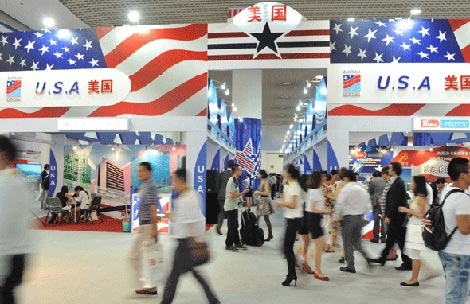Assessing FTZ after first year
Updated: 2014-11-28 13:20
By Li Yang(China Daily USA)
|
||||||||
|
The port in Shanghai FTZ saw a boom in foreign trade this year. Gao Erqiang / China Daily |
 Chinese leaders confirmed the Shanghai Free Trade Zone's (FTZ) pursuit of reforms in business registration, trade and government on the first anniversary of the experimental field's establishment.
Chinese leaders confirmed the Shanghai Free Trade Zone's (FTZ) pursuit of reforms in business registration, trade and government on the first anniversary of the experimental field's establishment.
The central government's positive assessment of the Shanghai FTZ kindled many local governments'passion to apply for new FTZs.The central government should be prudent in deciding whether to create new FTZs.
The FTZ craze appeared for the first time after the Shanghai FTZ was created. Dozens of cities applied to set up FTZs, boasting of their unique advantages.
It is the second time that some local governments, especially from the coastal regions, have shown strong interest in establishing new FTZs.
Chinese leaders have proposed building a Silk Road Economic Belt on the Eurasian continent and a 21stCentury Maritime Silk Road to boost regional integration and trade with the countries and regions in the Pacific Ocean and Indian Ocean.
The two proposals have been upgraded to national strategies and create a larger context for the second wave of FTZ desires among local governments.
Tianjin, Guangdong, Guangxi, Shandong, Fujian are the five likeliest candidates. Tianjin and Shandong's applications target China's trade with South Korea. Trade with Hong Kong and Macao is central to Guangdong's application. Trade with Taiwan is Fujian's main card, and Southeast Asia is key in Guangxi's application.
These applicants only see FTZs' missions in promoting trade, and downplay their roles in pursuing reforms in finance and government, which are actually the main headache-makers for a Shanghai FTZ administration that has seen some of its main leaders reshuffled sometimes twice a year.
According to Shanghai FTZ to-do list, what it has done lags far behind its three-year schedule. The central authority required Shanghai to provide mature models of financial and government reforms to transplant across the country.
The Shanghai FTZ's main achievements are that it makes business registration easier, and its administration implements a long "negative list" in governance to cut red tape and mark limits of government power. The market players can do whatever they want on the list, with which the government has no power and rights to intervene.
The Shanghai FTZ business registration system stresses an easy registration and strict supervision, a major change from the previous one, which was difficult and lacked supervision. The new system greatly stimulates Chinese people's passion in creating and running their own businesses.
In the first eight months of this year, the number of newly registered businesses increased by 15.75 percent year over year. Meanwhile, the registered business capital, a must in starting business in China, rose by 66.7 percent year over year.
The "negative list" governance model gives more freedom and space to the enterprises, which benefits enterprises from home and abroad; facilitates trade; and transforms the government into public service providers and market order maintainers.
In the first eight months, Shanghai FTZ's import and export business increased by 11 percent year over year, and the logistics cost decreased by 10 percent.
But the difficult reforms, such as renminbi exchange rate, an interest rate-forming mechanism, and interest rates, require joint efforts of different ministries.
What Shanghai has done is within its own power and does not affect the other ministries. Shanghai authority has repeatedly appeal for the central government's coordination of different ministries to help the FTZ fight against the resistance from the vested interest.
Otherwise, it is almost impossible for Shanghai to win the uphill battle alone.
Many applicants believe the central government can mete out favorable policiesand increase input for future FTZs, despite the central authority's denial of doing so a year ago.
China urgently needs to make breakthroughs in the key reforms in the Shanghai FTZ rather than creating more FTZs.
Deng Xiaoping created the several special economic zones and many open-up cities along China's coast in the 1980s to push market reform.
Only Shenzhen fulfilled its task as special economic zone for a longer time, and almost all the other zones and cities lost their luster several years later after exhausting the favorable policy bonuses.
After China completes its reforms, the country may have more FTZs. The appearance of more FTZs should be a natural result of the economic and trade development of the country, instead of a reflection of the government's will.
Contact the writer at liyang@chinadaily.com.cn

 Daredevil dancer conquers mountain
Daredevil dancer conquers mountain
 Chinese float gives joy at Macy's parade
Chinese float gives joy at Macy's parade
 Calm comes to troubled Ferguson
Calm comes to troubled Ferguson
 6 things you should know about Black Friday
6 things you should know about Black Friday
 Visa change may boost tourism to the US
Visa change may boost tourism to the US
 China's celebrity painters
China's celebrity painters
 Beauty of Beijing float making debut in Macy's parade
Beauty of Beijing float making debut in Macy's parade
 Rescue dogs show skills in NW China
Rescue dogs show skills in NW China
Most Viewed
Editor's Picks

|

|

|

|

|

|
Today's Top News
China, US fight terror on the Internet
How to give is focus of philanthropy forum
China, US diverge on approaches to nuclear energy
China's local govt debt in spotlight
Macy's looks to appeal to more Chinese customers
Clearer view of Africa called for
Cupertino, California council is majority Asian
BMO Global Asset Management Launches ETFs in Hong Kong
US Weekly

|

|








